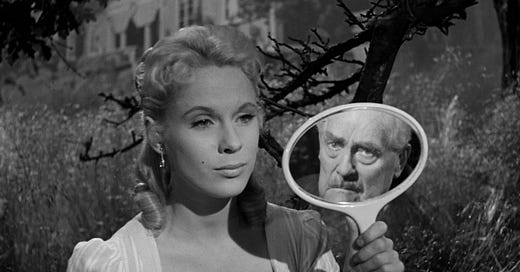100 Movies Every Catholic Should See #112: Wild Strawberries (1957)
Written & Directed by Ingmar Bergman
Where is that friend, whom everywhere I seek?
When the day dawns, my longing only grows;
When the day flees, I still cannot find Him
Though my heart burns.I see his traces, wherever power moves,
a flower blooms, or a leaf bends.
In the breath I draw, the air I breathe
His love is mixed.I hear his voice, where summer winds whisper,
where groves sing and where rivers roar
I hear it best in my heart speaking,
and me keeping.O! When so much beauty in every vein
of Creation and life fail,
How beautiful must the source be,
The eternally True!
This is the hymn the protagonist of Wild Strawberries, Professor Isak Borg (Victor Sjöström) recites around the midway point of the film, amidst a heated argument between two young men over the existence of God. While this film is not directly focused on that perennial question, it still lingers, especially considering Bergman made this right after he made The Seventh Seal.
Raised by a Lutheran minister who treated him rather harshly, Bergman’s exploration of his relationship with God is, to put it mildly, a complicated one. The Swedish director’s films of the 1950s and 1960s are more focused on these existential questions than those that would come later, after Bergman reached international acclaim.
However, like Hitchcock before he gained traction in America, the films of Bergman of this era are some of the best films ever put to celluloid, and after rewatching Wild Strawberries in preparation for this article (having only seen it once before two years ago), I am increasingly convinced that this is his best work.
The film follows Professor Borg on a day-long journey to Lund, where he is to receive the degree of ‘Doctor Jubilaris’ after 50 years of tenure. He only has one son to his name, Evald (Bergman regular Gunnar Björnstrand) and no grandchildren as of yet, although his son is married, to Marianne (Ingrid Thulin). After the first in a series of nightmares that will haunt him throughout the film, the stubborn professor decides he will be driving himself to Lund that day instead of his loyal housekeeper, Agda (Jullan Kindahl), and finds himself joined by Marianne, who reveals she is thinking of separating from her son.
The two begin their travel, but not before the first of Isak’s lucid reveries, taking him back to his youth, when he was engaged to his beautiful cousin Sara (another Bergman regular, Bibi Andersson). These memories are in part based on the director’s own childhood in Uppsala, particularly the summer stays at his grandmother’s house. Given that Isak recalls this as his mother’s house, it is not a stretch to see this film as a reflection of Bergman on his own complicated relationship with his father and an imaginative exercise on what his father’s childhood must have been like, and what may have formed him into the man he became. This is also evidenced by the casting of Björnstrand as Isak’s son: it is my own personal theory that Bergman often uses the actor as a placeholder for himself in his stories, such as the cynical squire in The Seventh Seal and the doubting pastor in Winter Light.
As the film progresses, Isak’s reveries get longer and more intricate, resembling Scrooge’s visions in “A Christmas Carol”. Adding to the surreal nature of the production, and recalling Bergman’s background in theater, several players that appear in these memories also appear in the main narrative in different roles: Andersson appears as a young hitchhiker who reminds the old man of his young love, and Gunnar Sjöberg plays both an angry husband that Isak meets on his journey and “The Examiner” in a later vision.
Despite the somber nature of the film, it is actually one of Bergman’s lighter stories, with humor abounding in older Isak’s interactions with the youth he encounters and between him and his maid of 50 years, Agda. Without spoiling too much, the ending is perhaps one of the director’s least cynical, leaving room for much hope for the family that had long suffered under Isak’s pride and stubbornness.
Considering Bergman’s decision later in life to live (and eventually die) on the island of Fårö and produce many of his films there, the film’s final shots are very poignant when considering where the director found the most peace in life. Perhaps making this film allowed him to think ahead to what kind of peaceful life he wanted to live in his final days, surrounded by nature on cool summer nights, abounding with wild strawberries.





